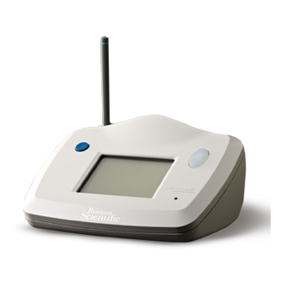Boston Scientific LATITUDE User manual

PATIENT MANUAL
PATIENT MANUAL
PATIENT MANUAL
PATIENT MANUAL
Caution: Federal (USA) law
restricts this device to distribution
and use by or on the lawful order of
a physician.
LATITUDE®Communicator
LATITUDE®Communicator
LATITUDE®Communicator
LATITUDE®Communicator

LATITUDE is a registered trademark of Boston Scientic Corporation
or its afliates.
Delta Mobile Systems is a trademark of Delta Mobile Systems
GlobTek is a registered trademark of GlobTek, Inc.

1
LATITUDE® Communicator Patient Manual
Table of Contents
LATITUDE Patient Management 3
The LATITUDE Communicator 3
Items You Should Receive 4
Optional Health Monitoring Equipment 5
Clinician Website 5
When to Use Your Communicator 6
When Not to Use Your Communicator 6
Where to Place Your Communicator 7
Important Notes 7
Identifying Buttons, Connectors and Indicators 9
How to Connect Your Communicator 10
Connections When Using a Telephone 11
Connections for the LATITUDE Cellular Data
Plan 14
Normal Operation of the Communicator 16
Indicator Sequence When Using the Heart Button 17
Indicator Descriptions 19
Status Button 24
Conrming Normal Operation 25
Troubleshooting Errors 27
Wave Indicator Colors 32
LATITUDE Cellular Data Plan 41
Activating the LATITUDE Cellular Data Plan 41
Troubleshooting and Support 42
Discontinuing Your LATITUDE Cellular Data
Plan 42
Interrogating Your Implanted Device 43

2LATITUDE® Communicator Patient Manual
What to Do if the Electrical Power is Interrupted 44
Checking that the Communicator Can Connect to
LATITUDE 45
Traveling with Your Communicator 46
Communicator Use of the Telephone System 46
What to Do If You Need to Use the Telephone
While the Communicator is Making a Call 48
DSL Internet Service 48
Care and Maintenance 49
Cleaning the Communicator 49
Returning or Replacing the Communicator 50
Communicator Disposal 50
Setting Switches for Your Country 51
Setting Switches for PBX or Dial-out Numbers 52
Connecting the USB Adapter 53
Specications 53
Safety and Standards Compliance 56
Software 58

3
LATITUDE® Communicator Patient Manual
LATITUDE Patient Management
LATITUDE Patient Management is a remote monitoring
system that gives your health care provider access to
your implanted device data between scheduled ofce
visits. The LATITUDE system is designed to improve
patient care while providing convenience to you.
The LATITUDE system uses advanced security
methods to protect your personal medical information.
Only authorized health care providers have access to
your information through the secure clinician website.
The LATITUDE system is not intended to assist with
medical emergencies. If you are not feeling well, call
your health care provider or dial 911.
The LATITUDE Communicator
The LATITUDE Communicator is an in-home
monitoring system that uses a wireless communication
system to communicate with your implanted device.
The Communicator does not provide continuous
monitoring. It automatically reads implanted device
information at times scheduled by your health care
provider.
At scheduled intervals, the Communicator sends
your device data to the LATITUDE system through a
standard telephone line or over a cellular data network
using the LATITUDE Cellular Data Plan (see page
41). The Communicator receives periodic schedule
updates made by your health care provider when it
connects to the LATITUDE system.

4LATITUDE® Communicator Patient Manual
The Communicator does not reprogram or change any
functions of your implanted device. Only your health
care provider can do this during an ofce visit.
Your Communicator is designed to be used only in the
United States, Canada, and Puerto Rico.
The telephone (land line) feature of the Communicator
is designed to operate on standard telephone lines
like those found in most homes. The Communicator
supports tone dialing over an analog line. The
Communicator may work on other telephone systems,
such as Digital Subscriber Line (DSL) and Voice over
IP (VoIP), if those systems provide an analog interface
for connecting the Communicator.
Read the instructions in this manual
thoroughly before using the Communicator.
Keep all of your LATITUDE information in a
convenient location for easy access in the
future.
Items You Should Receive
The following items are included with the
Communicator:
• Communicator unit
• AC adapter (GlobTek® Model GTM41060-1505)
• Communicator installation guide
• Communicator patient manual (this book)
• Accessories:
• Communicator telephone cord

5
LATITUDE® Communicator Patient Manual
Optional Health Monitoring Equipment
If prescribed by your health care provider, your
Communicator can also collect information from
an optional LATITUDE Heart Failure Management
System. This system includes a LATITUDE Scale and
LATITUDE Blood Pressure Monitor.
These specially designed products provide additional
information to monitor your health. Refer to the
handbook that is included with the weight scale and
blood pressure monitor products.
An accessory for the Communicator is a USB adapter
that is included with the scale and blood pressure
monitor.
Clinician Website
The clinician website provides authorized health care
providers a convenient and secure way to obtain and
analyze information from a patient’s implanted device.
The LATITUDE system normally displays your device
information on the clinician website within 15 minutes.
However, it may take longer for your information to
appear due to many external factors.
The website provides advanced analysis and trending
tools designed at improving patient care. Only your
physician and medical personnel authorized by
your physician can access your medical data on the
password-protected clinician website.

6LATITUDE® Communicator Patient Manual
When to Use Your Communicator
The Communicator performs many functions
automatically on a regular schedule that is set by
your health care provider. Other functions require you
to respond when the indicators on the front of the
Communicator light or ash. Check the Communicator
daily to see if any of the indicators are lit or ashing.
Use the Communicator only as instructed by your
health care provider. The Communicator’s Heart button
(Figure 1 on page 9) may ash if it needs you to
manually complete a scheduled interrogation of your
implanted device. If the Heart button is ashing, press
it and then watch the indicators on the Communicator.
Call your health care provider if the Call Doctor icon
(Figure 2 on page 10) is lit.
When Not to Use Your Communicator
The Communicator is designed to work only with your
implanted device. It will not work with another patient’s
implanted device. The Communicator should be used
only as authorized by the prescribing physician. The
Communicator is not for use with any pulse generator
other than a Boston Scientic device.
Ask your health care provider if you have questions
about any risks with using the Communicator or your
implanted device. There is also valuable information
about risks and reliability in the patient handbook for
your implanted device.

7
LATITUDE® Communicator Patient Manual
Where to Place Your Communicator
Place your Communicator:
• Near a telephone wall jack (not required if you are
subscribed to the LATITUDE Cellular Data Plan).
• Near an electrical outlet that is easily accessible.
• Where you can sit comfortably and see the front
of the Communicator.
• Close to where you sleep or near your bedside.
If this is not possible, place your Communicator
where you spend a considerable amount of time
each day.
Important Notes
• It is very important that the Communicator remain
plugged into the electrical outlet.
• Your Communicator should remain connected to
a telephone line unless you are subscribed to the
LATITUDE Cellular Data Plan.
• This equipment needs to be installed and put into
service in accordance with the information in the
provided documentation. Call your health care
provider if you need assistance setting up or using
your Communicator.
• Some household appliances and other sources of
electromagnetic energy could interfere with wireless
communication between the Communicator and
your implanted device. When you are using the
Communicator, you should be at least 3 ft (1 m)
away from televisions, VCRs, DVD players, personal
computers, and other electronic equipment.

8LATITUDE® Communicator Patient Manual
• Electrical safety: It is recommended that the customer
install a surge protector between the electrical
wall outlet and the Communicator. This is to avoid
damage to the Communicator caused by local
lightning strikes and other electrical surges.
• Boston Scientic personnel may contact the clinic
or patient if an implanted device uses too much RF
telemetry to perform remote interrogations.
Other manuals for LATITUDE
2
This manual suits for next models
1
Table of contents
Other Boston Scientific Cell Phone manuals





















